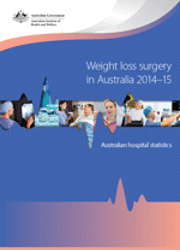Summary
Nearly two-thirds (63%) of Australian adults are overweight or obese (ABS 2015).
Weight loss surgery may be considered for the treatment of Australians with a body mass index (BMI) over 40 or those with a BMI of 35 and conditions that may improve with weight loss (NHMRC 2013).
In 2014–15, there were about 22,700 weight loss surgery separations.
Weight loss surgery separations are hospitalisations that include 1 or more weight loss surgery procedures.
- Over 79% of weight loss surgery separations involved a primary or initial procedure. The remainder were adjustments, revisions, removals and other procedures—for example, for adjustment or removal of devices.
- There were 9.7 weight loss surgery separations per 10,000 population. Western Australia had the highest rate at 17.3.
- The estimated total cost for the 2,700 weight loss surgery separations in public hospitals was almost $30.4 million.
In 2014–15:
- Around 18,000 (79%) weight loss separations were for female patients and 4,800 for male patients.
- Females aged 35–44 and males aged 45–54 had the highest number of separations.
In 2014–15:
- There were more than 124,600 weight loss surgery-related procedures billed to Medicare—those provided in public and private hospitals and in non-hospital settings.
- Total costs for the Medicare-billed procedures were about $62.8 million. About $25.7 million in benefits were paid by Medicare, and out-of-pocket costs for patients and/or health insurers were about $37.1 million.
Between 2005–06 and 2014–15:
- Weight loss surgery separations increased from 9,300 to 22,700.
- Separations increased 3.3 fold in public hospitals and 2.4 fold in private hospitals.
- The majority of procedures (around 89%) were performed in private hospitals.
Preliminary pages: Acknowledgments; Abbreviations; Symbols
1 Introduction
1.1 What is weight loss surgery?
1.2 Data sources
1.3 Structure of this report
2 Overweight and obesity in Australia
2.1 How many people are overweight or obese?
2.2 Have rates of overweight and obesity changed over time?
2.3 Where do we rank against other countries?
3 Weight loss surgery for admitted patients
3.1 Weight loss surgery separations
3.2 How much weight loss surgery was there in 2014–15?
3.3 Have weight loss surgery separations changed over time?
3.4 Who had weight loss surgery?
3.5 Why did people have weight loss surgery?
3.6 How urgent was the care?
3.7 What weight loss surgery was provided?
3.8 What do we know about the safety and quality of the care?
3.9 How long did people wait for surgery in public hospitals?
3.10 How long did patients stay?
4 Estimated cost of weight loss surgery for patients admitted to public hospitals
4.1 What was the estimated cost of the care?
4.2 Who paid for the care?
5 Weight loss surgery-related procedures funded by Medicare
5.1 Medicare weight loss surgery-related procedures
5.2 What weight loss surgery was funded by Medicare in 2014–15?
5.3 Who used weight loss surgery funded by Medicare?
5.4 How much did this care cost?
6 Areas for further work
6.1 Publicly funded non-admitted patient care
6.2 Outcomes from weight loss surgery
6.3 Patient journeys
6.4 Medicare items
6.5 Indigenous identification
6.6 Total costs
Appendixes:
Appendix A: Database quality statement summaries
Appendix B: Technical appendix
Appendix C: Weight loss surgery-related ACHI procedure codes and Medicare Benefit Schedule items used for this report
End matter: Glossary; References; List of tables; List of figures; List of boxes



